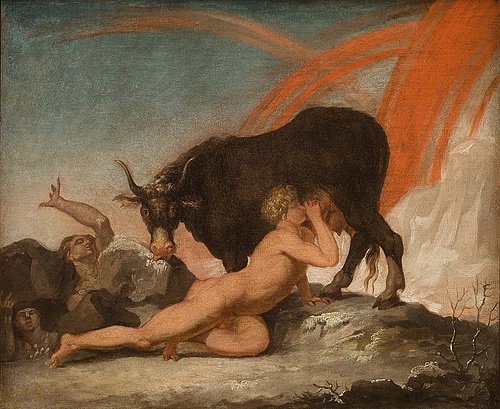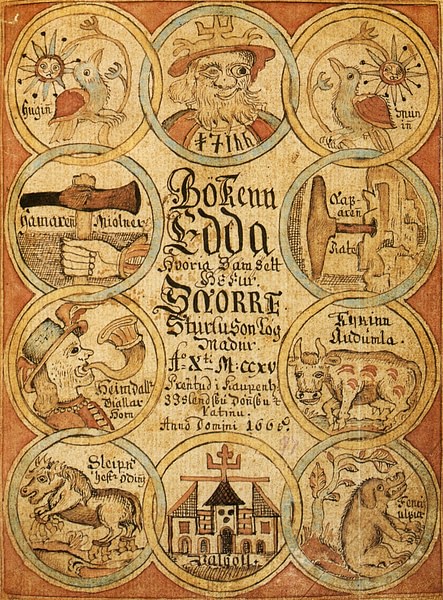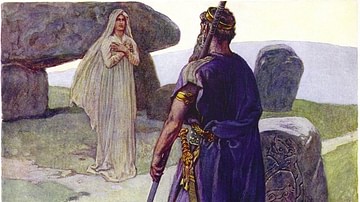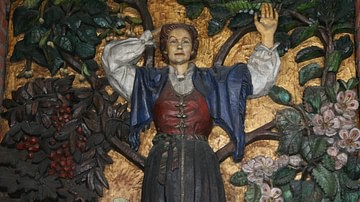
Ymir is a primordial giant, closely linked to the creation myth and the beginning of the world in Norse mythology. A creature resulting from the dramatic encounter between ice and fire, he was fed by a cosmic cow and his body parts served as the building blocks of the universe.
He is able to beget offspring all by himself, one of his descendants being the mother of Odin. Odin and his brothers would end up killing him though, and they would shape all that exists out of his body. His scattered brains would become the clouds, and the borders of the known world would be encircled by his eyebrows.
Creation of the World
The Norse creation myth is told in detail by Snorri Sturluson, the Icelandic scholar and law-speaker (the person reciting the laws at the assembly) who in the 13th century CE tried to retell these myths in a text called Gylfaginning (The Deceiving of Gylfi), part of a larger book, the Prose Edda. He was inspired by texts of the Elder or Poetic Edda, a compilation of poems written in the same century but believed to be much older based on its language and content. As such, we must take Snorri’s words with a serious pinch of salt because as it is really hard to tell how much he contributed himself to the older Norse myth. The story in Gylfaginning tells of Gylfi, a legendary king of Sweden who goes to Asgard, the realm of the gods, to ask them questions in order to figure out whether they use magic so as to fulfill their will. Gylfi is tricked into believing he is talking to the gods and the palace he arrives to is real, but in the end, he does find answers to the ardent cosmological questions.
In the beginning, Snorri is quoting the first text of the Poetic Edda, the Völuspá (Old Norse Vǫluspá), where it says there was nothing but a giant void, probably filled with some kind of magic potential. Before our world was formed there existed an icy misty world called Niflheim, with a well from which eleven rivers flowed. Another world was the elemental opposite, Muspell, hellishly hot. It is not very clear what happens next, there were probably several versions of the myth incorporated into one, which might explain the difficulty. The main idea seems to be that the rivers of Niflheim froze and the ice piled up in the void, where the rime met the heatwaves from Muspell. As a result of the melting, the drops came together to shape a being, Ymir or Augelmir, the ancestor of the giants’ families. Whether Snorri made this up or not, it is definitely a colorful story: Ymir’s sweat gave birth to a male and female, and his legs conceived a child as well.
Ymir was not the only one formed by the molten ice of Niflheim. The rime also took the shape of a cow, Audhumla (Auðumbla), who fed Ymir. The cow had a very special diet apparently, licking the salty blocks of rime. As a result, she also created a being out of the rime, a man called Búri, who in his turn had a son named Borr. Borr married a giantess, Bestla, and their children were the gods Odin, Vili, and Vé. Little is known about the last two, but the former rose to the highest seat in the divine world, worshipped by all, and associated with a lot of attributes: leadership, wisdom, deceit, sorcery, pragmatism, strength.
Finally, the divine trio committed the murder that would be the base of everything that surrounds us. They killed Ymir the giant, and so much blood was spilled and flowed that the rest of the giants, except for one family, drowned in it. The three gods could now build the earth. As Snorri tells us:
They took Ymir and transported him to the middle of Ginnungagap [the void], and out of him made the earth, out of his blood the sea and the lakes. The earth was made of the flesh and the rocks of the bones, stone, and scree they made out of the teeth and molars and of the bones that had been broken. (12)
As you might suspect, his blood became the sea that in Norse mythology encircled the earth, so it was impossible to cross. His skull became the sky, and it was fixed with four points, more accurately dwarves: Austri (east), Vestri (west), Nordri (north), Sudri (south).
The gods then took sparks flying randomly from Muspell and threw them in the sky so that could lighten up the earth: the stars. They fixed their courses, too. After this description, Gangleri - the name used by Gylfi the king who is asking all of these questions about the gods, the universe, and so on - expresses his amazement at all this information and wants to know more. He is told that the earth is circular, around it is the sea, and on the shores live the races of giants. On the inner side of the earth, the gods built a fortification to protect the worlds against the aggressive giants, and for it, they used another piece of Ymir; his eyelashes. They call the fortification Midgard (Miðgarðr).
Other Sources
Snorri took elements from two other poems in the Poetic Edda, namely Vafþrúðnismál and Grímnismál, which also speak of the sea, earth, and sky being made out of Ymir’s parts. Both poems attempt to be encyclopedic, containing a lot of names and facts. The former poem is conceived as a contest dialogue between Odin and the giant Vafthrudnir to see who is wiser. When asked about the origin of the earth and skies, the giant mentions in stanza 21 that it was out of Ymir’s flesh the world came about. Later on in stanza 28, he also tells that the oldest of Ymir’s kin was Bergelmir, the one who escaped in a boat after the bloodbath caused by Ymir’s sacrifice. This has been interpreted by some as an influence of the Biblical story of the flood.
Another character mentioned here, Aurgelmir, is probably another name for Ymir because when Odin asks about Aurgelmir’s origin, Vafthrudnir answers with the same story about the venomous frozen waters and then how he produced children from his armpit and feet. The latter poem, Grímnismál, revolves around Odin who by mistake is tortured by a king who does not know who he is. On this occasion, he shares knowledge with the king’s son, Agnar. Stanzas 40 and 41 contain the creation story, highlighting Midgard, made for manna sunum ("sons of man").
Cultural Parallels
Ymir, a creature both a mother and a father, in other words a hermaphrodite, has counterparts in some Iranian and Indian stories. In Zorvanism, the god Zorvan, for example, gave birth to the twins Ahura Mazda and Angra Mainyu (also known as Ahriman) who created everything fair and everything dark, respectively. In the Rigveda, the sacred text of ancient India, we have the story of Purusha, a primordial being sacrificed and portioned out to create the social classes, moon, sun, heaven, and the important deities Indra and Agni. Moreover, the term Ymir might have a correspondent in Indo-Iranian Yama, meaning 'twin'.
According to Michael Witzel, there is also a number of similar examples from South Asian mythologies. One such character is Pangu, a primordial giant that burst out of a cosmic egg and started forming the land, skies, valleys, rivers, but whose work was never complete until he died.
From his skull was shaped the dome of the sky, and from his flesh was formed the soil of the fields, from his bones, came the rocks, from his blood the rivers and seas, from his hair all vegetation. His breath was the wind, his voice made thunder, his right eye became the moon, his left eye the sun. from his saliva or sweat came the rain. And from the vermin which covered his body came forth mankind. (Witzel 2017, 371).
At least partially similar stories come from Polynesia, Japan, Afghanistan, or Kashmir. The Maori god Tangaroa opens his shell and builds the universe with it. In Kashmir, the giant demon Rakshasa is killed and an embankment is built from his remnants on a river using his leg and knee. However, we must take into account that the different traditions of these stories are separated by both space and time and the myths are not directly connected.
Ymir not only created the giants but also the gods as Odin’s mother was a giantess. Moreover, the story of Ymir reminds us of the strong connection between the idea of sacrificing something and someone and through this sacrifice creating the universe. Thus judging by his role, Ymir seems to be one of the essential characters of myth.








